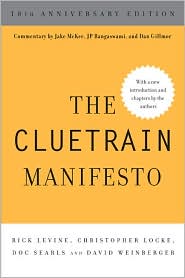July 2, 2016
Corrupting "Earned media"
The Intercept reports on several news media who are selling special services at the national political conventions — meetings, cocktail parties, and more. The services are corrosive. Some are explicitly corrupt, “…they make explicit the inevitable failure of the distinction between “paid” and “earned” content.”making explicit the inevitable failure of the distinction between “paid” and “earned” content.
The less controversial services are corrosive because they let the media take money from the people they cover. Having spent a few decades as a marketing communications guy, I can promise you that in every business considering these offers, the conversation includes someone saying, “It doesn’t matter if no one comes to the cocktail party. It’d still improve our relationship with the publication.” Why? Because it’s a way to pay the journal money. That’s corrosive.
Larry Lessig points out that it’s not much different from news organizations tuning their coverage to their ratings. But such tuning at least caters to perceived piopular interest. These new services let an organization or candidate buy coverage despite a decided lack of public interest. It is worse than buying ads because the news media have traditionally had a “Chinese wall” between the advertising and editorial departments. This has been a fairly effective way of protecting editorial content from the direct influence of the marketing needs of the journal, even though the wall is sometimes breached, and Time Magazine has shamefully torn it down.
Once the media started letting companies pay for phony news coverage, they pretended to honor the breach by distinguishing “earned” and “paid” content. “Earned content” is coverage provided by media of events they think are newsworthy. “Paid content” is, well, paid content. Non-sleazebag companies and their PR reps expect media to mark paid content as paid for. Edelman, the world’s largest independent PR company, created ethical guidelines that not only say that the paid content must be well marked, but that Edelman will have its own Chinese wall between the processes by which earned content is pitched (“Yo, I have a client who’s invented a time travel machine. Wanna an interview? How’s yesterday for you?”) and the negotiations that result in the placement of paid content. (Disclosure: I had a tiny hand — Trump-sized — in drafting those guidelines.)
That’s better than nothing, but paid content still makes me queasy. Companies are willing to pay for content precisely because it looks like real coverage and thus tends to be taken more seriously than obvious ads. This erodes the phenomenological line between news and ads, which is bad for democracy and culture. Indeed, “the point of paid content is to erode the line. ”the point of paid content is to erode the line.
But letting candidates pay for interviews takes this to a whole new level. This is what The Intercept says:
Sponsors who pay $200,000 are promised convention interviews with The Hill’s editorial staff for “up to three named executives or organization representatives of your choice,” according to a brochure obtained by The Intercept. “These interviews are pieces of earned media,” the brochure says, “and will be hosted on a dedicated page on thehill.com and promoted across The Hill’s digital and social media channels.”
The Hill says the resulting interviews will be earned media. Suppose the interview is stupid, boring, self-serving and non-newsworthy? If it weren’t, the client wouldn’t be paying for it. But The Hill is promising it’s going to run anyway because the client paid them $200,000. That is the very definition of paid content. So, by calling it “earned content,” The Hill can only mean that the article will not be marked as paid content, even though that is precisely what it is.
This corrupts the already corrosive practice of accepting paid content. It is disgraceful.








